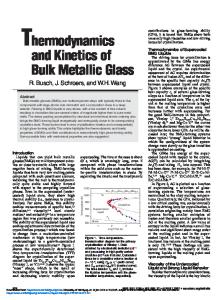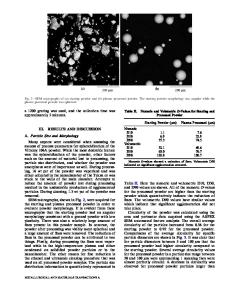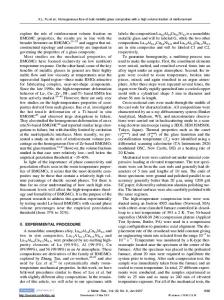Unusually high erosion resistance of zirconium-based bulk metallic glass
- PDF / 317,295 Bytes
- 5 Pages / 584.957 x 782.986 pts Page_size
- 42 Downloads / 293 Views
Harpreet Singh Grewal and Harpreet Singh School of Mechanical, Materials and Energy Engineering, Indian Institute of Technology Ropar, Rupnagar, Punjab 140001, India
Brij Kumar Dhindaw Brunel Center for Advanced Solidification Technology, Brunel University, Uxbridge, Middlesex UB8 3PH, United Kingdom
Sundeep Mukherjeea) Department of Materials Science and Engineering, University of North Texas, Denton, Texas 76203 (Received 5 August 2013; accepted 30 September 2013)
The liquid impingement erosion behavior of a zirconium-based bulk metallic glass (BMG), Zr44Ti11Cu10Ni10Be25, was evaluated in this study. For comparison, commonly used hydroturbine steel was evaluated under the same test conditions. BMG demonstrated more than four times higher resistance against cavitation erosion compared with hydroturbine steel. The unusually high erosion resistance for BMG is attributed to its uniform amorphous structure with no grain boundaries, higher hardness, and ability to accommodate strain through localized shear bands.
I. INTRODUCTION
Surface degradation of materials by erosion and corrosion has serious economic implications. In particular, fluid machinery such as turbines, pumps, valves, and propellers are subject to extensive surface damage due to the repetitive impact of liquid jets over long periods of time. These impacts result in material loss in the form of cavitation or liquid impingement erosion. In addition, shock waves produced from the dynamic interaction during cavitation also contribute toward surface damage.1 Significant research efforts have been directed toward finding sustainable solutions to address the deleterious effects of surface degradation. Majority of these studies have focused on the utilization of appropriate coatings. However, coatings have serious limitations including porosity, low adhesion, and nonhomogenous microstructure.2,3 Therefore, discovery and development of new materials that are resistant to cavitation erosion damage can have a sizable economic impact. Bulk metallic glasses (BMGs) have received considerable attention in structural applications due to their high strength, high elastic strain limit, and thermoplastic forming ability.4–7 Despite these desirable properties, only limited work has been done in evaluating erosion behavior of metallic glasses. The erosion–corrosion behavior of Zr55Cu30Ni10Al5 metallic glass has been studied in saline-sand slurry using a pot-type a)
Address all correspondence to this author. e-mail: [email protected] DOI: 10.1557/jmr.2013.298 J. Mater. Res., Vol. 28, No. 22, Nov 28, 2013
http://journals.cambridge.org
Downloaded: 14 Mar 2015
erosion tester.8 The metallic glass showed higher resistance to erosion–corrosion compared with 304 stainless steel. Cavitation erosion performance of several Zr-based BMGs was evaluated in a previous study using an ultrasonic vibration device.9 The influence of chemical composition and mechanical behavior of the different alloys on erosion performance was investigated.9 However, there is limited understanding
Data Loading...











